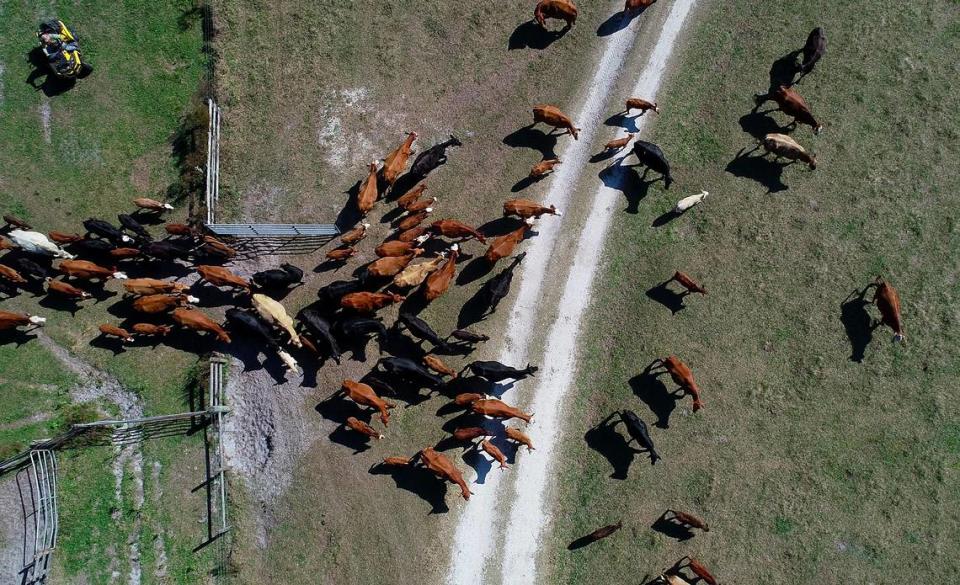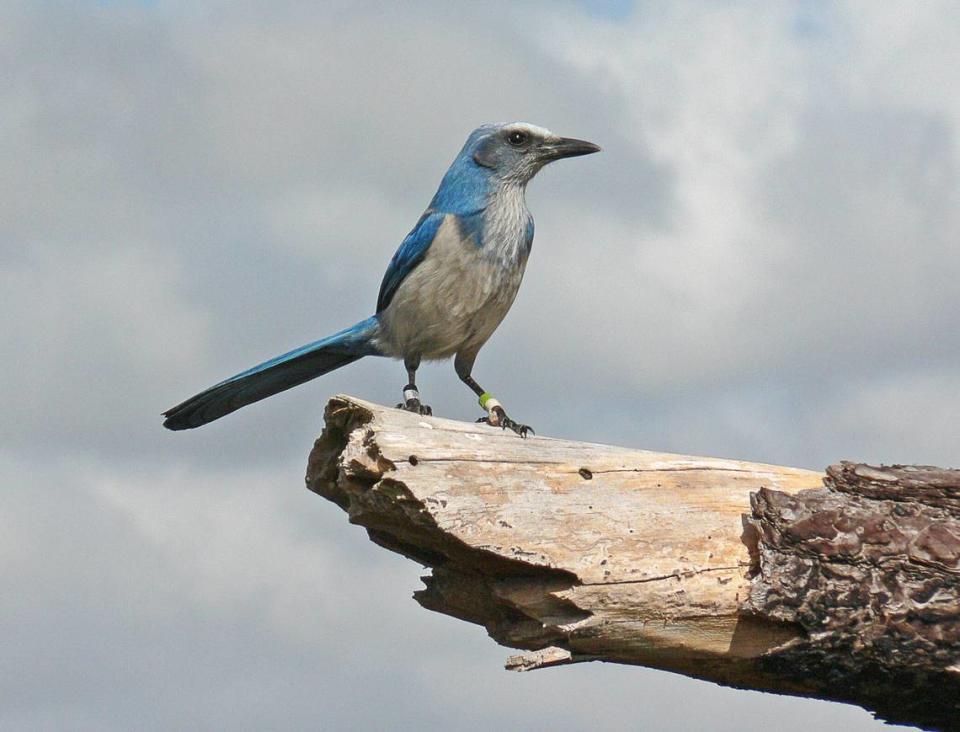New program aims to protect rural Florida land from heavy development in Manatee County
A new conservation effort proposed by the federal government seeks to protect some of Florida’s remaining undeveloped lands, and it could include parts of Manatee and Sarasota counties.
Dubbed the Everglades to Gulf Conservation Area, the project maps out a 4-million-acre region spanning 12 Southwest Florida counties. If the plan is approved, the U.S. Fish and Wildlife Service will try to purchase conservation land from willing sellers within that boundary.
“We have a few short years to protect this landscape,” said Florida Conservation Group director Julie Morris. “Every bit of funding counts.”
FCG, a nonprofit with a focus on Southwest Florida conservation, is one of many groups partnering with the federal agency to bring the new conservation area to fruition.
In addition to outright land buys, the program would also offer landowners the option of establishing a conservation easement on their property. In an easement, a landowner maintains ownership of the land but gives up or limits rights to develop the property or disturb natural habitat.
Conserving ranch land helps environment, group says
FCG works with ranchers to establish easements in Manatee and surrounding counties.
“Our focus has been on working lands,” Morris said. “We want to keep them in business and economically viable. If we want to protect threatened and endangered species, we need these ranch lands. They are the land use that most closely mimics the native savanna prairie.”
Federal funding will add an extra resource for all the groups working to conserve lands that are rapidly being bought up for development, Morris said.
“This funding is a complement to the state efforts. It provides more options for landowners,” Morris said.
Landowners who opt for an easement can still use the land for low-impact agriculture like ranching, nature-based recreation like fishing, hunting, hiking and camping and minimal structures, such as a single-family home and barn, the U.S. Fish and Wildlife Service says.
“We’re going to need a mixture of land buys and easements if we want to have viable wildlife, clean water and clean air,” Morris said.
“Recognizing the generations of responsible stewardship within this working rural landscape, the Conservation Area proposes to work with willing landowners to secure a legacy of conservation lands for future generations to enjoy,” U.S. Fish and Wildlife’s project description states.
“The proposed Conservation Area would aim to address threats from habitat fragmentation and urban development, altered ecological processes and impacts from global climate change.”
Jim Strickland, a lifelong rancher from a multi-generational ranching family in East Manatee County, has participated in several easements, including on the property he currently manages at Blackbeard Ranch in Myakka City.
Strickland also serves as vice-chair of the Florida Conservation Group and is a co-founder of Florida Cattle Ranchers, a business partnership that promotes sustainably-raised Florida beef and ranch land preservation.
Strickland said that while easements aren’t for every landowner, it has been a rewarding experience for his and other families.
“I think its a combination of a philosophical and a financial decision,” Strickland said.
Strickland said that landowners who participate in easements are helping to preserve important environmental benefits of undeveloped land, such as aquifer recharge, wildlife habitat, carbon sequestration and wetland protection.
“What’s Florida going to look like 500 years from now?” Strickland said. “The citizens of Florida have said they really want to conserve land. This is an opportunity.”
It’s also a means to preserve an agricultural way of life that is quickly disappearing.
He noted that demand for easements is skyrocketing among Florida landowners, which could be a promising sign for the proposed federal program.
“History tells us that almost all the development we see now used to be cattle grazing lands. So that gives you a hint about the future. I’m the guy that wants to see a balance,” Strickland said.

More land for Florida Wildlife Corridor
The federal project aims to bolster state efforts that are already underway to acquire and protect habitat for the Florida Wildlife Corridor, a network of connected conservation land that runs the length of the peninsula.
The Florida Wildlife Corridor spans nearly 18 million acres of “wilderness and working lands crucial to the survival of many of Florida’s 131 imperiled animals,” the Florida Wildlife Corridor Foundation says.
Animals that rely on lands in the corridor include the endangered Florida panther, the Florida scrub jay, gopher tortoises, manatees and black bears.
“In addition to protecting wildlife, conserving wild spaces is crucial to mitigating climate change, as studies show that natural spaces play a significant role in reducing greenhouse gases and guarding against the impacts of increased temperatures,” the Florida Wildlife Corridor Foundation says.
Of the 18 million acres, about 8 million are unprotected.
The Florida Wildlife Corridor Act, signed into law in 2021, encourages further conservation in the area. In May, the Florida Cabinet approved an addition of almost 40,000 acres to the corridor.

Manatee, Sarasota County have important habitat
The proposed Everglades to Gulf Conservation Area encompasses a significant portion of eastern Manatee and Sarasota counties.
In Manatee County, the proposed area includes almost 3,000 parcels of potential conservation land totaling over 163,000 acres, according to the U.S. Fish and Wildlife Service, and in Sarasota County, it includes more than 10,000 parcels totaling over 164,000 acres.
The agency estimates that about 11% of Manatee County and 56% of Sarasota County are currently protected.
Locally, the Conservation Foundation of the Gulf Coast is responsible for conserving many of those acres by funding projects like Johnson Preserve and the Myakka Headwaters Preserve in Manatee County.
The land trust, which recently celebrated its 20th birthday, infuses money from private donors into the land-buying process and helps facilitate talks between government agencies and landowners.
So far, the foundation has protected over 19,200 acres in Southwest Florida as it works to link the region to the Florida Wildlife Corridor. The ultimate goal is a network of conservation lands that would span from Duette Preserve in Manatee running south through Sarasota, Charlotte, Lee and Collier counties to the Everglades, said Conservation Foundation President Christine P. Johnson.
Johnson said that while there’s much conservation to celebrate in the region, there’s a lot more work to do.
“Are we keeping pace with development? Are we keeping up with the pace of growth in Florida? The answer is no,” said Christine P. Johnson, president of the Conservation Foundation.
“What we need help with is money,” Johnson said.
Johnson said the new conservation plan could “open the door” for federal and state funds to come together.
“That’s how these corridors happen, when we all work together,” Johnson said.
The new conservation plan places a special emphasis on protecting the Myakka River watershed, which winds through Manatee and Sarasota counties before feeding into Charlotte Harbor and the Gulf of Mexico. The Peace River watershed, which runs through Polk, Hardee, Desoto and Charlotte counties, is also a focus.
“The watersheds are increasingly impacted by development, intensive agriculture and phosphate mining,” the U.S. Fish and Wildlife Service says. “But there are also important opportunities to protect remaining natural uplands, wetlands and ranchlands that all contribute to water resource protection.”
The plan’s scope notes that it can also help Manatee County’s Environmental Lands Program meet its goals of protecting ecologically important areas within the county. In 2020, voters approved a referendum directing the county to purchase more conservation lands.
To date, the county has not yet purchased any land with the funds.
What’s next for the conservation project?
The U.S. Fish and Wildlife Service is taking public comment on the proposal through the end of October.
Comments can be emailed to southeast_fws_planning@fws.gov.
The agency will host in-person comment sessions in Wauchula and Immokalee later this month, and virtual public meetings will be held online on Friday, Oct. 20, and Thursday, Oct. 26, from 4 to 6 p.m. Registration is required and can be completed at fws.gov/project/everglades-gulf-conservation-area.
What happens after public comment?
“Once the public review and comment period ends, the Service will evaluate and respond to substantive comments and make any changes needed before developing a final plan, which would be submitted to the Service Director requesting approval,” USFWS says.
What is the timeline for completing the Everglades to Gulf Conservation Area?
“This is a long-term effort that may take decades to complete. The number of willing landowners and the availability of funding would determine the timeline,” USFWS says.

